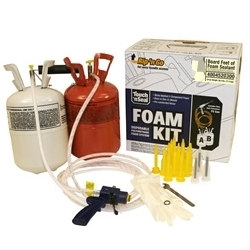
Polyurethane foam has been around since the 1970s, but its use has recently exploded with more and more people jumping on the conservation bandwagon. DIY spray on insulation is a simple, cost-effective solution to air leaks in the home, blocking air intrusion and escape at the same time. In order to get the most out of foam insulation, here are a few bits of information to keep in mind.
What Foam Do You Need?
The biggest factor to consider when deciding which foam to use is simply this: how much area do you need to cover? Both the high expansion foam and low expansion foam expand to cover the area where sprayed, but they differ in a few ways as well.
High Expansion Foam
High expansion foam covers larger gaps, cracks, and the like than low expansion foam. It also expands 30x when sprayed at 1″ thickness, so I’d advise against spraying liberally.
Low Expansion Foam
In contrast, low expansion spray foam is best used on smaller gaps and only expands by 10%.
How to Use the 2-tank Foam System
The 2-tank foam system makes installing foam insulation an easy do-it-yourself project, so as with any DIY project, make sure to wear protective gear.
In the 2-tank foam system, Tank B must be warmed up to make it the same creamy consistency as A; this allows for an even stream of foam. A few methods for warming Tank B include:
- Keeping it in a warm room
- Putting it in a tank warmer
- Warming the tank in an electric blanket
The 2-tank system uses high expansion foam, so remember that spraying 1″ of thickness will expand 30x.
Which Rooms Need it the Most?
When installed in the draftiest, gap-ridden areas in the home, polyurethane foam insulation can save you up to 20% on cooling and heating costs alone. So which areas have the most potential for energy loss?
Attic and Garage
These areas typically suffer from poor insulation, making it easy for winter and summer to wreak a lot of havoc. Attics and garages can sometimes reflect (and even magnify) the temperature outside. The main source of insulation problems come from the ceiling and walls; check these first before going over the rest of the room for any missed gaps and cracks.
Basement
Basements often deal with humidity, which can lead to mildew and mold. First, make sure the basement receives proper ventilation, then seal all the air leaks. For basements, air leaks can be found around areas that lead outside, like air vents, ducts, and pipes.
Home Exterior
It may not seem like a big deal, but exterior gaps can cause just as much insulation problems as the ones inside. Dryer vents and water faucets (with hoses) are unexpected culprits of air leaks and can also contribute to that inflated energy bill you see each month.
Applying polyurethane foam insulation will help you control the temperature in your home and finally get a better grasp on the outcome of your energy bill.

This was great to help figure out what to use on our attic. We just moved into a new home and it’s a fixer upper. We now just need to find a company to come out and install the foam now that we know what we need.